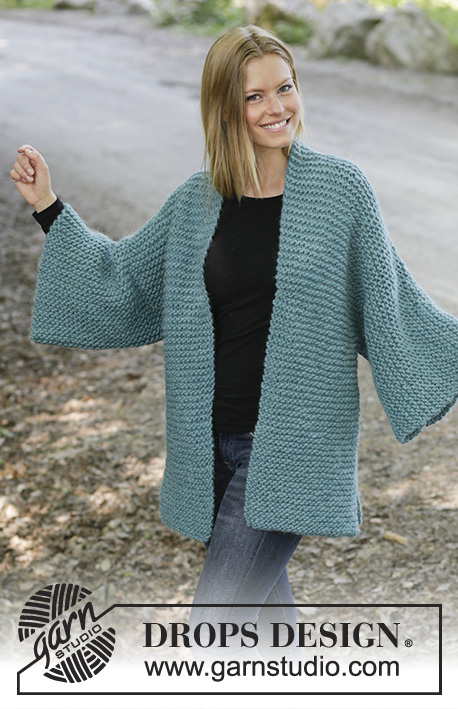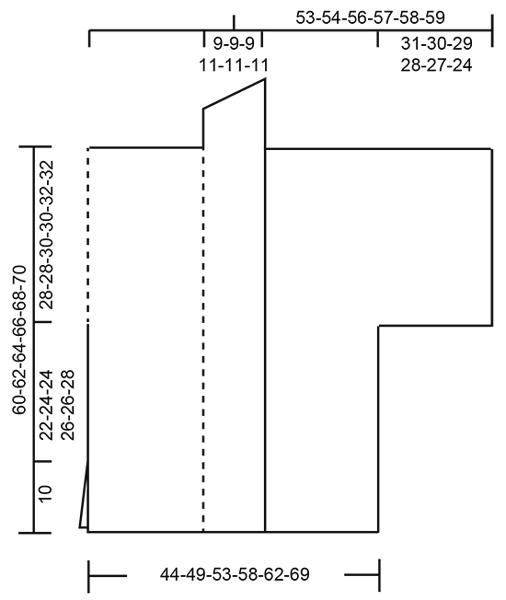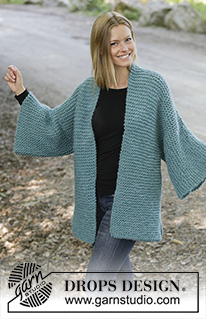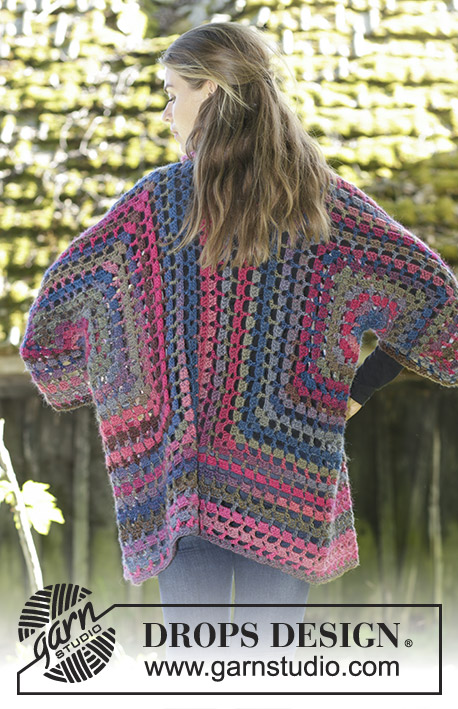Comments / Questions (25)
![]() JJW Van Der Westhuizen wrote:
JJW Van Der Westhuizen wrote:
Love this, patern please
23.05.2025 - 12:42DROPS Design answered:
Dear JJW, here here is the pattern in English. Happy knitting!
25.05.2025 - 15:38
![]() Dorothye wrote:
Dorothye wrote:
Lovely sweater to knit
11.03.2025 - 03:32
![]() Gunvor Kvammen wrote:
Gunvor Kvammen wrote:
Veldig fin jakke, men ville gjerne hatt den i et annet garn, eventuelt samme farge,og ikke så veldig veldig dyr.Må ha hjelp fra dere, og da kjøpet jeg Pinner må jeg ha med , men tror jeg kan gå ned til 9 mm
11.09.2024 - 15:45
![]() Anne wrote:
Anne wrote:
Bonjour, je ne comprends pas l'histoire du col. J'ai bien 2 petits morceaux de chaque côté en plus mais si je les couds ça me fait un col fermé avec un trou pour passer la tête. Et je ne comprends pas non plus "coudre le long de l'encolure dos". Si je fais ça, ça me fait un bourrelet. Peut-être que les 2 parties du col à assembler sont le devant et le derrière, une fois à gauche et une autre fois à droite ?? J'ai l'impression que ça ressemble plus à un truc comme ça :)
20.01.2024 - 21:21
![]() Ulrike wrote:
Ulrike wrote:
Hallo, die Jacke sieht toll aus, aber ich verstehe die Anleitung zum Kragen nicht. Ausgangspunkt sind 10 Maschen. Für das Muster stricke ich im 1. Schritt eine Krausrippe über alle 10 Maschen und dann im 2. Schritt heißt es eine Krausrippe über 7 Maschen. Und wie stricke ich die verbleibenden 3 Maschen? Das ist mir nicht klar. Danke für die Antwort.
30.12.2023 - 07:54DROPS Design answered:
Liebe Ulrike, es wird hier verkürzten Reihen gestrickt, damit der Kragen höher an der Ausserseite als an der Innenseite wird, die Innenseite wird dann am Halsausschnitt genäht. Viel Spaß beim stricken!
02.01.2024 - 10:34
![]() Lena wrote:
Lena wrote:
Hej. Jag skulle ville använda hålmönster från ”feel the beat” kofta. Skulle det fungera och behöver jag då mer eller mindre garn? Med vänlig hälsning, Lena
18.06.2023 - 15:36DROPS Design answered:
Hei Lena. Tenkte du på å strikke jakken "Emerald Isle" med hullmønstret fra "Feel the Beat Cardigan"? Siden det er brukt 2 ulike garnkvaliteter, den ene er med riller og den andre er med hullmønster og den ene er lang og den andre er kort kan vi ikke gi et 100% riktig svar på garnlengden. mvh DROPS Design
19.06.2023 - 11:15
![]() Michelle wrote:
Michelle wrote:
Hi. I would love to make this pattern,but in worsted weight yarn ,bernat premium yarn,\r\nIs there a pattern written for this yarn please?\r\nThankyou.
10.01.2023 - 18:32
![]() Macarena wrote:
Macarena wrote:
Hola. ¿Cómo se teje el pliegue del cuello? Muchas gracias
10.06.2022 - 19:34DROPS Design answered:
Hola Macarena, puedes consultar el siguiente vídeo sobre cómo trabajar el pliegue del cuello: https://www.garnstudio.com/video.php?id=438&lang=es
16.06.2022 - 20:05
![]() Lynn wrote:
Lynn wrote:
Can I please have this pattern in English
18.05.2022 - 20:02DROPS Design answered:
Dear Lynn, sure, click on the scroll down menu below the photo and choose either English (UK/cm) or English (US/IN) as you like. Happy knitting!
19.05.2022 - 08:54
![]() Rose S wrote:
Rose S wrote:
Für mich ist die Frage, was stellt das Diagramm dar? Welche Seiten bzw. worauf beziehen sich die Größenangaben in cm , auf die gesamte Seite oder eine halbe Seite der Jacke.
20.01.2022 - 12:29DROPS Design answered:
Liebe Rose S, die untere Angaben sind für die gesamte Breite, die oberre (53... 59 cm für die Hälfte: von der Mitte Halsauschnnitt am Rückenteil bis zur Ende der Ärmel); die Angaben an der linken Seiten sind die Höhen. Hier lesen Sie noch mehr. Viel Spaß beim stricken!
20.01.2022 - 17:07
Emerald Isle#emeraldislejacket |
|
 |
 |
Knitted jacket in DROPS Snow. The piece is worked in garter stitch with shawl collar, split in sides and kimono sleeves. Sizes S - XXXL.
DROPS 196-41 |
|
|
EXPLANATIONS FOR THE PATTERN: ------------------------------------------------------- RIDGE/GARTER STITCH (worked back and forth): 1 ridge = Knit 2 rows. MEASURING TIP: Due to the weight of the yarn and the fact that you are working in garter stitch, always measure the piece when holding it up or the garment will be too long when worn. ------------------------------------------------------- START THE PIECE HERE: ------------------------------------------------------- JACKET - SHORT OVERVIEW OF THE PIECE: The front pieces are worked first, back and forth with circular needle. They are worked bottom up and new stitches are cast on for the sleeves in the sides. Then the front pieces are put together and you continue over the back piece from the top down. Using this method, there are no shoulder or sleeve seams. The piece is sewn together to finish, under the sleeves and down the sides. RIGHT FRONT PIECE: Cast on 26-28-30-33-35-38 stitches with circular needle size 10 mm and Snow. Work GARTER STITCH – read description above. REMEMBER THE KNITTING TENSION! When the piece measures 32-34-34-36-36-38 cm - read MEASURING TIP, cast on 28-27-26-25-24-22 new stitches at the end of the next row from the right side = 54-55-56-58-59-60 stitches. Continue with garter stitch until the piece measures 60-62-64-66-68-70 cm – adjust so that the next row is worked from the wrong side. Insert 1 marker on this row – this will be used to measure the length of the back piece. On the next row (from the right side) place the outermost 10-10-10-12-12-12 stitches towards mid front on a thread for collar, but to avoid cutting the strand you are using, work the stitches before placing them on the thread = 44-45-46-46-47-48 stitches left on needle for shoulder, work to end of row. Knit 3 rows back and forth over these stitches (the last row is worked from the wrong side) and then place these 44-45-46-46-47-48 stitches on 1 thread. Work collar and then left front piece as described below. COLLAR RIGHT FRONT PIECE: Place the 10-10-10-12-12-12 stitches from the thread mid front back on the needle. Start from the wrong side and knit 1 row. Then work garter stitch back and forth as follows: * Work 1 ridge back and forth over all stitches, work 1 ridge back and forth over the first 7-7-7-9-9-9 stitches *, work from *-* until the collar measures 6-6-6-7-7-7 cm at the narrowest part, but finish after 1 knitted row from the wrong side over all stitches. Cast off with knit from the right side or place the stitches on 1 thread. LEFT FRONT PIECE: Cast on 26-28-30-33-35-38 stitches with circular needle size 10 mm and work garter stitch. When the piece measures 32-34-34-36-36-38 cm cast on 28-27-26-25-24-22 new stitches at the end of the next row from the wrong side = 54-55-56-58-59-60 stitches. Continue with garter stitch until the piece measures 60-62-64-66-68-70 cm – adjust so that the next row is from the wrong side. Insert 1 marker on this row – this will be used to measure the length of the back piece. Knit 44-45-46-46-47-48 stitches from the right side and place the remaining 10-10-10-12-12-12 stitches towards mid front on 1 thread for collar. Knit 3 rows over these 44-45-46-46-47-48 stitches (the last row is worked from the wrong side) and then place the stitches on a thread. Work collar and then back piece as described below. COLLAR LEFT FRONT PIECE: Place the 10-10-10-12-12-12 stitches from the thread mid front back on the needle. Start from the right side and knit 1 row. Then work garter stitch back and forth as follows from the wrong side: * Work 1 ridge back and forth over all stitches, work 1 ridge back and forth over the first 7-7-7-9-9-9 stitches *, work from *-* until the collar measures 6-6-6-7-7-7 cm at the narrowest, but finish after 1 knitted row from the wrong side over all stitches. Cast off with knit from the right side or place the stitches on 1 thread. BACK PIECE: Start from the right side and knit over the 44-45-46-46-47-48 stitches from the left front piece, cast on 8-8-8-10-10-10 new stitches on the needle (= neck at back) and knit over the 44-45-46-46-47-48 stitches from the right front piece = 96-98-100-102-104-106 stitches on needle. Work garter stitch back and forth until the piece measures 28-28-30-30-32-32 cm from the markers inserted on the shoulders – remember MEASURING TIP. Cast off 28-27-26-25-24-22 stitches at the beginning of the next 2 rows = 40-44-48-52-56-62 stitches left on needle for the back piece. Continue with garter stitch until the piece measures 60-62-64-66-68-70 cm from the markers on the shoulders – adjust so that the front and back pieces are of equal length. Then loosely cast off from the right side. ASSEMBLY: Fold the piece double at the markers on the shoulders with the wrong side on the inside. Sew under arm and side seams in one go – the side seams are sewn in the outermost loop of the outermost stitch so that the seam is flat, but stop when you have 10 cm left (= split). Sew the collar together mid back inside the cast off edge - make sure the seam is towards the wrong side when the collar is folded down. If the stitches are on threads, sew the stitches together with grafting stitches. Sew the collar to the neck at the back. |
|

|
|
Have you finished this pattern?Tag your pictures with #dropspattern #emeraldislejacket or submit them to the #dropsfan gallery. Do you need help with this pattern?You'll find 15 tutorial videos, a Comments/Questions area and more by visiting the pattern on garnstudio.com. © 1982-2025 DROPS Design A/S. We reserve all rights. This document, including all its sub-sections, has copyrights. Read more about what you can do with our patterns at the bottom of each pattern on our site. |
|




















































Post a comment to pattern DROPS 196-41
We would love to hear what you have to say about this pattern!
If you want to leave a question, please make sure you select the correct category in the form below, to speed up the answering process. Required fields are marked *.